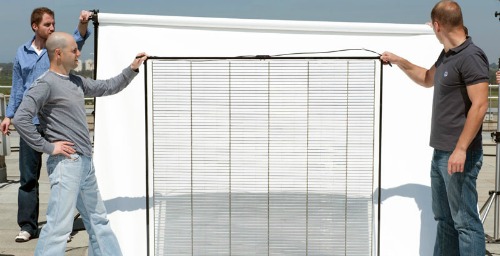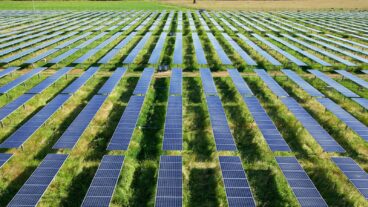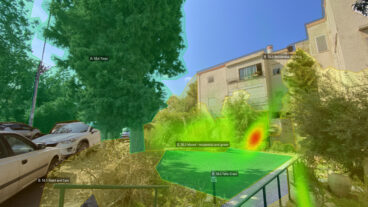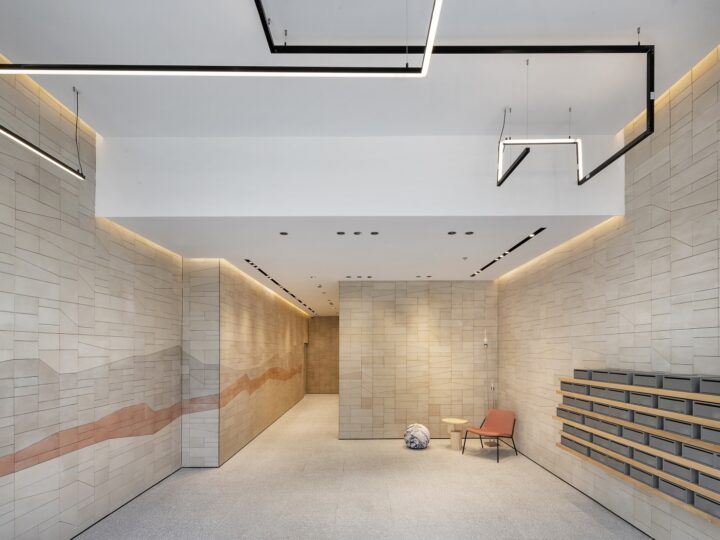
The dream of constructing a net zero-energy building has yet to become a reality, but now an Israeli company has come up with an idea that could make it possible.
The innovative product from Pythagoras Solar can be described as a solar window that combines energy efficiency, power generation and transparency.
The world’s first transparent photovoltaic glass unit (PVGU) has been designed to be easily integrated into conventional building design and construction processes. This means that existing office blocks can be retrofitted with the new material instead of energy-seeping glass windows – a process that will pay itself back within five years.
“What we have today – this is what we hear from architects – is very unique,” Pythagoras Solar CEO Gonen Fink tells ISRAEL21c. “The high transparency makes for esthetically pleasing building designs.
“There are many companies today doing energy-efficient windows or energy generators using photovoltaics such as skylights, but this is mostly to show you can produce energy from the building’s envelope. This is the first time somebody has actually combined the advantages in one product.”
Prestigious award
In June, Pythagoras Solar’s breakthrough was selected from nearly 5,000 entrants as a winner of the prestigious GE Ecomagination Challenge (challenge.ecomagination.com), which recognizes the most promising innovations for capturing, managing and using energy in buildings.
“GE sets high standards and we are proud that our technology has been recognized as a distinctive solution, ready for the real world and set to enable a market shift towards net zero-energy buildings,” said Udi Paret, vice president for marketing and business development.
“This award, along with its $100,000 prize, validates our proposition and supplements the increased interest we are seeing from successful pilots, first commercial projects and growing product demand.”
The company was co-founded in 2007 by Fink and Dr. Itay Baruchi (CTO). Before Pythagoras Solar, Fink helped turn Check Point Software Technologies from an early-stage start-up to a multi-billion dollar global market leader in internet security. Baruchi is an expert in neuronal networks, whose work on biological memory was named one of the “50 Most Significant Scientific Breakthroughs” by Scientific American in December 2007.
“The idea was to use innovative optics with solar cells to produce a new product that would allow solar energy to become part of the next generation of building design,” Fink explains.
“The application that we very early saw as most attractive was using optics to produce benefits such as allowing light into the building, power generation and reducing the building’s power needs.”
Further, he notes, “The need to improve the energy efficiency of buildings has been in the news a lot recently. Many companies are trying to come up with solutions that would reduce energy consumption. We want daylight, but not the heat because of the air-conditioning costs involved as result.
“Until now, the only solution has been to block windows with curtains or blinds — and that means you need more artificial lighting. Our optical design allows multiple advantages, by using direct light to generate energy. This is done with something that doesn’t look like a solar panel, but a window. This makes the whole concept more attractive to architects.”
Building revolution
“People underestimate the revolution that’s happening in the construction industry,” says Fink. “In almost every country there are more regulations relating to buildings’ energy consumption. The Obama administration has just set a new target – to reduce energy use by 40 percent.”
The United States Department of Energy estimates that building operations account for up to 39% of the country’s energy consumption and 70% of its power plant-generated electricity. Over 30% of this energy is lost through poor building efficiency.
“Within the industry there’s greater understanding of the needs, and the progress that’s been made is huge. It’s clear to me that new commercial buildings in the coming years will include power generation and energy efficiency. It is going to become a standard,” says Fink.
Having developed the product, the company carried out pilot projects last year in several commercial buildings in the US and Israel. “We took existing buildings, such as the Sears Tower in Chicago – a small part of it, just two windows to begin with – and showed that it works. Then we went to the next stage, which is commercial installation and expanding our manufacturing capacity. We are working with some of the largest glass companies in the world,” says Fink.
Pythagoras is based in Silicon Valley, and much of the production takes place in Los Angeles. The company’s R&D center is in Israel.
“The company is about to take off,” Fink says confidently. “There’s a good reason for my optimism. This is the first time we can bring power generation to green buildings. Until now it’s all been about reducing energy consumption. Ours is the first product that actually combines both. By combining this facet with power generation, we can change the equation.”















